Laptop Mag Verdict
The Yoga C630's gorgeous design and outstanding battery life make up for below-average ARM laptop performance.
Pros
- +
Superslim, flexible design
- +
Aluminum chassis
- +
Very long battery life
- +
LTE connectivity
Cons
- -
Poor price-to-performance ratio
- -
Stiff keyboard
- -
Hollow audio
Why you can trust Laptop Mag
The Qualcomm-powered Lenovo Yoga C630 (starting at $859) combines the productivity of a laptop with useful smartphone features, including LTE connectivity and always-on access. But those conveniences come at the expense of performance, which is well-short of what equivalent Intel-powered laptops offer.
Still, the 13.3-inch Yoga C630 does a lot of things right to justify its steep price. The Ultrabook has a sleek, aluminum chassis, and this machine's outstandingly long-lived battery can last well into a second day of use. While the Yoga C630 may be too expensive to be a secondary device, this laptop is a good option for frequent travelers or anyone who wants a premium machine for everyday use. It's also one of the laptops with best battery life.
Lenovo Yoga C630 Price and Configuration Options
Lenovo currently offers the Yoga C630 in three configurations. For $859, the base model we reviewed comes with a Qualcomm Snapdragon 850 CPU, 4GB of RAM and a 128GB SSD. Doubling the laptop's memory to 8GB increases the price to $939. From there, you can double the storage to 256GB by going with the $999, top-of-the-line model.
Design
The Yoga C630 makes a wonderful first impression.
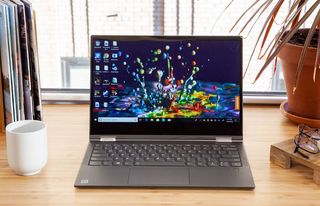
The sleek notebook adopts the same simple-yet-elegant design language we've seen on other consumer-based Lenovo laptops, like the Ideapad 530S and Yoga C930. The Yoga C630's chassis sports a black Yoga logo embossed in the corner of the stylish Iron Grey lid.

The sexy industrial color scheme continues onto the deck, where two speaker grills flank a full-size keyboard. Apart from the lid's futuristic Yoga logo, the only other branding is "Lenovo" smartly written on one of the dual hinges.
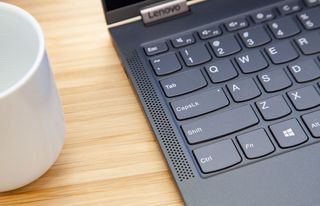
Speaking of which, the flexible hinges rotate 360-degrees, transforming the Yoga C630 from a laptop into a tablet. You can also orient the Yoga C630 into tent mode for viewing content or fold the screen flat for giving presentations to others. I found that the hinges don't require much pressure to rotate, yet they are sturdy in laptop mode.
Lenovo has done an impressive job reducing the size of its laptop's bezels without compromising webcam placement. While the Yoga C630 flaunts that engrossing design element, the notebook's bottom frame is still rather chunky.
The Yoga C630's refined design and industrial slate color scheme give it a premium look and feel, but what I really can't get over is the device's tiny footprint.
Lenovo has done an impressive job reducing the size of its laptop's bezels without compromising webcam placement.
At 2.7 pounds and 12.1 x 8.5 x 0.5 inches, the 13-inch Yoga C630 is understandably larger and heavier than the 12-inch HP Envy x2 (11.5 x 8.3 x 0.3 inches, 2.7 pounds with cover) and 12-inch Samsung Galaxy Book 2 (11.3 x 8.9 x 0.3 inches, 1.75 pounds) tablets, but not by much. The 14-inch Acer Spin 3 (13.2 x 9.1 x 0.8 inches, 3.6 pounds) is considerably larger and heavier than the Yoga C630.
Ports
If you've already added the C630 to your shopping cart, then you might as well add a few dongles while you're at it. A compromise of going thin is that the Yoga C630 has limited ports.
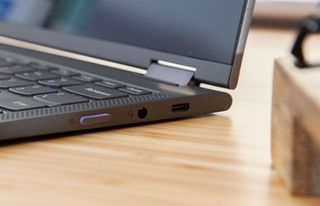
The right side contains a USB-C port and a headphone/mic jack, while you'll find another USB-C and a SIM card holder on the left side.

A Thunderbolt 3 input and an SD card slot are two notable omissions from the Yoga that you do find on other premium Ultrabooks.
Display
The Yoga C630's 13.3-inch display is detailed and vivid, but I wish it were brighter.

In the trailer for the upcoming Hellboy film, the half-demon's body was a rich, blood-red color, and a brief scene of a burning city singed my eyes with a vivid orange glow. The 1080p panel was so crisp that I could see every scar on Hellboy's face and all of the marks on his powerful Right Hand of Doom.
The display on our Yoga C630 review unit exhibited a yellow tint when I viewed YouTube videos and visited my favorite web pages. I went ahead and tinkered with Windows 10's calibration software, which improved the display's white balance considerably.
The Yoga C630's screen reproduced 120 percent of the sRGB color gamut, just about matching the Envy x2's result (121 percent) and the premium laptop average (117 percent). The stunning OLED panel on the Galaxy Book 2 is significantly more colorful, at 200 percent, than the Yoga's screen, while the Spin 3's lags far behind (69 percent).
MORE: Laptops with the Most Colorful Screens
I wish the display on the Yoga C630 were brighter for better visibility outdoors. The 267 nits of peak brightness we measured on the Yoga C630 falls behind the Envy x2's showing (486 nits), the Galaxy Book 2's result (350 nits) and the premium laptop average (318 nits). The Spin 3's panel (237 nits) is even dimmer.
I had no problems using the Yoga's touch-screen display in tablet mode to navigate the web and draw a picture in 3D Paint.
Keyboard and Touchpad
Lenovo has a knack for making excellent keyboards, which is why the one on the Yoga C630 is a letdown.
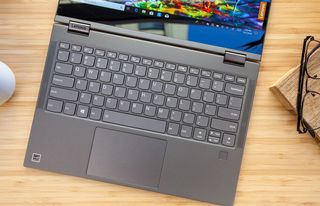
The keys are shallow, with just 0.9 millimeters of travel (well below our preferred 1.5 to 2mm), and despite having an actuation force of 65 grams, the keyboard feels a tad stiff. The good news is that Lenovo somehow found a way to fit a full-size keyboard on the C630's small frame, so your fingers won't have to scan for keys. I also appreciate the two levels of adjustable backlighting.
Unfortunately, our review unit came with a loose keycap. A replacement laptop Lenovo sent us didn't have any issues, suggesting the problem isn't widespread.
I typed at 113 words per minute, with an accuracy rate of 94 percent on the 10fastingers.com typing test. That tops my 109-wpm average but at a slightly higher error rate than my usual 5 percent.
The 4.0 x 2.7-inch glass touchpad on the C630 is large and responsive. I had no issues executing Windows 10 gestures, including three-finger swipe to switch apps and pinch-to-zoom.
Audio
The top-firing speakers on the deck of the Yoga C630 produce dull, congested audio. When I listened to Devon Gilfillian's "Here and Now," the groovy soul song sounded lifeless. While the speakers were able to fill a medium-size room, their high-pitch treble tones pierced my ears, forcing me to turn the volume down to about 50 percent. The Yoga C630 didn't do much better with Flora Cash's "You're Somebody Else," which sounded like it was coming through a tin can.
Performance
The Snapdragon 850 CPU (Qualcomm's first made-for-PC chip) inside the Yoga C630 doesn't solve the performance woes of the chip's predecessor. The CPU struggled to keep up in my real-world testing, which involved loading 15 Google Chrome web pages and simultaneously playing two 1080p YouTube videos and a pair of Twitch streams. Websites took a while to load; I noticed lag when switching between tabs, and some graphics took several seconds to appear.

Our benchmark tests illustrate a stark gap in performance between the latest Snapdragon chip and Intel's Core processors. The Yoga C630, equipped with 8GB of RAM, scored 3,221 on the Geekbench 4 overall performance test, which tops the result from the Envy x2 (Snapdragon 835, scoring 2,989) and comes close to the Galaxy Book 2's showing (Snapdragon 850, scoring 3,545). However, the Yoga gets crushed by the Intel Core i5-wielding Spin 3 (12,172) and the average premium laptop (12,149).

The Yoga C630's hard drive is slow, as well. It took the Ultrabook 39 seconds to transfer 4.97GB of mixed-media files from one folder to another, for a rate of 130 megabytes per second. That just tops the sluggish rate of the Galaxy Book 2 (118 MBps) and the Envy x2 (128GB UFS, 108.3 MBps), but it's slower than the Spin 3's result (256GB Serial ATA/600 SSD, 145.5 MBps). Things get real ugly when you compare the Yoga C630's hard drive speeds to the premium laptop average (510.2 MBps).
Our benchmark tests illustrate a stark gap in performance between the latest Snapdragon chip and Intel's Core processors.
The Yoga C630 needed 4 minutes and 9 seconds to pair 65,000 names to their corresponding addresses in Excel. That is significantly longer than the time put up by the Envy x2 (2:43), Galaxy Book 2 (2:18) and the Spin 3 (1:29). It also falls short of the premium laptop average (1:37).
Graphics
The Yoga C630 can run some of the lightweight games found in the Windows Store, but don't expect to play Fortnite on this machine.
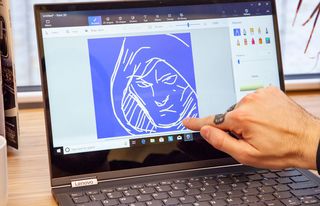
With an Adreno 630 GPU, the Yoga C630 scored a measly 26,570 on the 3DMark Ice Storm Unlimited graphics test. That's a step below what the Galaxy Book 2 (30,420) scored, but less than half of what the Acer Spin 3 (UHD Graphics 620, scoring 61,440) achieved. The premium laptop average (85,573) is more than three times higher than the Yoga's result.
MORE: Best Graphics Performance
We tried playing Dirt 3 on the C630, but our efforts were in vain. The racing game played at a laggy 17 frames per second, far below our 30-fps threshold. The Qualcomm chip inside the Galaxy Book 2 (24 fps) didn't fare much better, while the Intel-powered Spin 3 (47 fps) ran the game with ease. The average premium laptop can run Dirt 3 at a steady 71 fps.
4G LTE
One of the biggest benefits of purchasing a laptop with a Qualcomm CPU is the built-in 4G LTE connectivity. The Snapdragon X20 LTE modem enables the Yoga C630 to connect to the internet without a Wi-Fi connection. Switching from Wi-Fi to LTE is a breeze: Just select the Cellular button in the Windows Action Center.

The Verizon network I tested on the Yoga C630 averaged fast 75.99-Mbps download speeds and 18.6-Mbps upload speeds on Speedtest.net. I appreciate the ability to manage my network settings using the pre-installed Verizon Connection Manager app.
Battery Life
What you lose in performance with a Snapdragon CPU, you gain in battery life. The Yoga C630 did an outstanding job on our Laptop Mag Battery Test (continuous web surfing over Wi-Fi at 150 nits of brightness), achieving a runtime of 12 hours and 14 minutes. That doesn't quite beat the epic battery life of the Envy x2 (14:22), but it does outlast the Galaxy Book 2's battery (10:41) and the Spin 3 (9:12) by a good margin. The premium laptop average (8:25) runtime is worse than each of these devices' times.
Webcam
Located above the display, the Yoga C630's 720p webcam produces grainy images. There was a distracting amount of visual noise in a selfie I snapped in our brightly lit office. My dark green sweater looked pale, and the bright lights hanging above my head were completely blown out. The camera, at least, captured a decent amount of detail in my face, but I still recommend upgrading to an external webcam.
Heat
For such a thin laptop, the Yoga C630 did an excellent job staying cool under a heavy workload. The touchpad (81.5 degrees Fahrenheit), keyboard (88 degrees) and underside (91 degrees) of the laptop all remained below our 95-degree comfort threshold after we played a 15-minute HD video. Only the bottom (99 degrees) of the notebook, near the hinge, heated to concerning temperatures.
Software and Warranty
The Lenovo Yoga C630 runs Windows 10 S out of the box, but you can upgrade to Windows 10 Home for free if you need to download third-party programs.
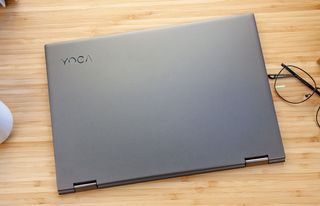
The only application Lenovo added to the Yoga C630 is Vantage. The app is meant to provide system updates and custom settings, but at the time of writing, it simply redirected me to the laptop's User Guide. We're working with Lenovo to gain access to the full app and will update this review once we've found a solution.
Other applications installed on the Yoga C630 include Phototastic Collage, the Candy Crush Saga, LinkedIn and Fitbit Coach.
The Yoga C630 ships with a one-year warranty. See how Lenovo did on our Tech Support Showdown and Best and Worst Brands ranking.
Bottom Line
The Yoga C630 makes for an awesome travel companion. The 13.3-inch device has an extremely portable and lightweight chassis that can easily fit inside of a backpack, and the laptop's outstanding battery life will get you through even the longest transcontinental flights. Better yet, LTE connectivity means you don't need to be tethered to a Wi-Fi connection to browse the internet.
Unfortunately, even Qualcomm's latest Snapdragon processor provides sluggish performance compared to other Intel-equipped premium laptops. Therefore, power users will need another primary device to deal with demanding workloads. Alternatively, compact-yet-capable Intel-powered Ultrabooks like Lenovo's own Yoga C930 and the Microsoft Surface Pro 6 give you the best of both worlds but lack some useful mobile features. That being said, the Yoga C630 is a good option if you need something to slip into your bag and use on the go.
Credit: Laptop Mag
Lenovo Yoga C630 Specs
| Bluetooth | Bluetooth 4.2 |
| Brand | Lenovo |
| CPU | Qualcomm Snapdragon 850 |
| Card Slots | SIM |
| Company Website | https://www.lenovo.com/us/en/pc/ |
| Display Size | 13.3 |
| Graphics Card | Adreno 630 |
| Hard Drive Size | 128GB |
| Hard Drive Type | UFS 2.1 |
| Highest Available Resolution | 1920 x 1080 |
| Mobile Broadband | Qualcomm Snapdragon X20 LTE |
| Native Resolution | 1920x1080 |
| Operating System | Windows 10 S |
| Ports (excluding USB) | USB Type-C, Combo Headphone/Mic Jack, SIM card |
| RAM | 8GB |
| Size | 12.1 x 8.5 x 0.5 inches |
| Touchpad Size | 4.0 x 2.7 inches |
| USB Ports | 2 |
| Warranty/Support | 1-year warranty |
| Weight | 2.6 pounds |
| Wi-Fi | 802.11ac |
Phillip Tracy is the assistant managing editor at Laptop Mag where he reviews laptops, phones and other gadgets while covering the latest industry news. After graduating with a journalism degree from the University of Texas at Austin, Phillip became a tech reporter at the Daily Dot. There, he wrote reviews for a range of gadgets and covered everything from social media trends to cybersecurity. Prior to that, he wrote for RCR Wireless News covering 5G and IoT. When he's not tinkering with devices, you can find Phillip playing video games, reading, traveling or watching soccer.
